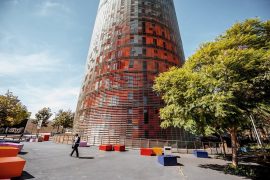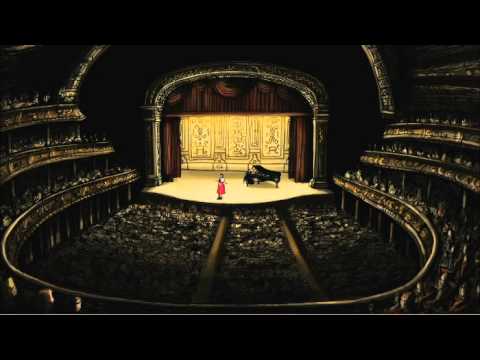
The Museu Marítim will host on October 28 the great...

When Rupert and Kristin Isaacson saw Rowan, their son with...

Currently, e-commerce generates 53 million purchases per year in Catalonia,...

From the Sociedad Catalana para el Alumbrado por Gas, founded...

The first session of the cycle on the regatta organized...

Would you like to walk around with the Giocconda under...

Barcelona has been an outstanding entrepreneurial centre for the technology...

The dFactory Incubator centre, capable of providing services simultaneously to...

Its spin-off, Peptomyc, is immersed in its second clinical trial,...
Until you become an expert driver, you have to realise...

Música clásica sobre la arena de la playa en dos...

The first session of the cycle on the regatta organized...

The hospital's managing director, Manel del Castillo, and the pharmaceutical...

Generalitat y Ayuntamiento impulsarán dos equipamientos de 'Casa de les...

Leticia Beleta, director of Alexion Pharmaceuticals in Spain and Portugal,...

We all have a friend who never leaves the Gràcia...

Barcelona director opts for Best International Film with 'La sociedad...

The hotel and industrial sectors softened the market's decline last...

The technology company, with a workforce of 35 employees and...

“The women of yesteryear were strong and had to fight...

[dropcap letter=”M”]
usic is 50% of a film, says Carolina López, “and we often don’t pay enough attention to it”. That means that we are blind to half a film. López is the director of the International Film Festival of Animation of Catalonia (Animac), which is organised by the Lleida Town Hall and got underway today: 312 films of varying lengths will be screened over the course of the four days of Animac, now in its 22nd edition and this year, spotlighting soundtracks. In fact, the Festival is celebrating the prestigious composer and sound designer Normand Roger, the creator of the soundtracks for films like The Man Who Planted Trees by Frédéric Back and ‘Father and Daughter‘ by Michaël Dudok de Wit. Likewise, it is also commemorating the career of the Catalan composer Zacarías M. de la Riva, the creator of the soundtrack of the successful animated film Tadeo Jones who has a fruitful output of original soundtracks for film, especially animations.
This 22nd edition of Animac is welcoming prominent names from around the world, such as Anna Budanova, the animator of Spring in the inaugural concert-film Animation for Vivaldi’s Four Seasons; the composer of the soundtrack nominated for the Oscars®, Revolting Rhymes, Ben Locket; the Israeli animator of Waltz with Bashir, Tal Gadon; the founder of the Belgian production company Camera-etc, Jean Luc Slock; the musician of the videogames by Amanita Design, Floex; the expert in animation and jazz, Milen Alempijevic; the creator of Arròs Covat, Juanjo Sáez; the Czech animator of The Oddsockeaters, Galina Miklínová; and the director of Buñuel in the Labyrinth of the Turtles, Salvador Simó, among others.
NETWORKING AND PITCH SPACE, THE SHOWCASE DEVOTED TO THE PROFESSIONAL ANIMATION INDUSTRY
Carolina López explains that the Networking and Pitch space continues to be a benchmark for emerging professionals in animated films: this year, the organisers of Animac have received 22 projects which are currently being gestated to participate in Incubator, 20 Portfolio to be reviewed by experienced mentors, and the presence of 13 companies and schools to participate in the Market Pitch.
Likewise, this 22nd edition of Animac expects to be visited by a large number of professionals from the sector, with more than 250 accredited visitors over the four days of the festival.
PIXAR AND COMPUTERS CHANGED ANIMATED FILMS
Since the last decade of the 20th century, the world of animation has undergone a major shift with the introduction of computers into the process of film production. The first animated film which was partly made with the assistance of a computer was Beauty and the Beast (1991): in the dance scene, a background and setting were created to give the sensation that the camera was moving in all directions. Since then, digital technology has been omnipresent in animated film and has enabled the visual complexity of films to be ramped up.
Pixar Animation Studios revolutionised the animated film industry: its technical quality, creativity and production values created a new generation of computer-animated films which not only garnered acclaim from audiences and critics alike but also earned them numerous Oscars. Since 1986, Pixar has been working on developing the production software used to create its own films through computer-generated graphics: RenderMan. This programme allows high-quality, rich and vibrant animated images to be created which are unique in the industry.
In May 1991, Pixar became associated with Walt Disney Pictures, initially to develop and produce three computer-animated films. Between 1992 and 1994, Pixar made around 29 advertisements and developed the logo of the companies IBM and Paramount. In a new association in 1997, Pixar and Disney produced five more films, including the short film Geri’s Game, which stood out for its advances in the ability to computer-animate skin and clothing. In 1999, Toy Story 2 stormed onto the market, the first film in history to be created and shown digitally. In 2003, Finding Nemo premiered, and Toy Story was voted the number 1 of the top 100 animated films in history by the Online Film Critics Society (OFCS). In the ensuing years, other hits followed, including The Incredibles and Cars. In January 2006, Pixar and Disney reached an agreement in which Pixar became a subsidiary owned by the Walt Disney Company. The next hits from Pixar/Disney were Ratatouille (2007), Wall·e (2008), Up (2009), Toy Story 3 (2010), Cars 2 (2011), Brave (2012), Monsters University (2013), Inside Out (2015), The Good Dinosaur (2015), Finding Dory (2016), Coco (2017) and Cars 3 (2017).
CATALONIA: FROM NOTHING TO THE INTERNATIONAL MARKET
Film production from Catalonia was poor for many years. Garbancito de la Mancha (1945) by Arturo Moreno was the first animated feature film in Spain. Later, El mago de los sueños (1966) by Francisco Macián was filmed. Currently, animation in Catalonia is centred in Barcelona, where animations meant for both films and television series have been produced.
At first, it all began with short films designed for the big screen. Later, Catalan animations found their way into the international market thanks to television series produced by Cromosoma such as Les Tres Bessones, Acció with 10+2 and Los Fruittis, among many others. The production companies had the support of television stations, especially Ràdio Televisió Espanyola and Televisió de Catalunya. Many productions drew inspiration from the world of comics, such as Historias de amor y masacre, and a series called Cobi, inspired by the mascot of the Barcelona Olympics.
The production of animated feature films seems to have taken off a bit in recent years. In 2009, Acció premiered a film called Cher Ami which resembles the Disney style, while the Mariscal studio that same year also premiered Chico i Rita, a production by Fernando Trueba which was targeted at an adult audience, unlike the majority of animation films, which are meant for children.
Some Catalan studios, like Grangel Studio in Barcelona, run by Carles and Jordi Grangel, have earned recognition abroad thanks to their partnerships with major American companies like Dreamworks, and with Tim Burton, by partnering on feature films like Madagascar, Antz, Kung Fu Panda, Bee Movie and Corpse Bride.
According to the Audiovisual Cluster of Catalonia, the most important Catalan animation companies today are:

[dropcap letter=”M”]
usic is 50% of a film, says Carolina López, “and we often don’t pay enough attention to it”. That means that we are blind to half a film. López is the director of the International Film Festival of Animation of Catalonia (Animac), which is organised by the Lleida Town Hall and got underway today: 312 films of varying lengths will be screened over the course of the four days of Animac, now in its 22nd edition and this year, spotlighting soundtracks. In fact, the Festival is celebrating the prestigious composer and sound designer Normand Roger, the creator of the soundtracks for films like The Man Who Planted Trees by Frédéric Back and ‘Father and Daughter‘ by Michaël Dudok de Wit. Likewise, it is also commemorating the career of the Catalan composer Zacarías M. de la Riva, the creator of the soundtrack of the successful animated film Tadeo Jones who has a fruitful output of original soundtracks for film, especially animations.
This 22nd edition of Animac is welcoming prominent names from around the world, such as Anna Budanova, the animator of Spring in the inaugural concert-film Animation for Vivaldi’s Four Seasons; the composer of the soundtrack nominated for the Oscars®, Revolting Rhymes, Ben Locket; the Israeli animator of Waltz with Bashir, Tal Gadon; the founder of the Belgian production company Camera-etc, Jean Luc Slock; the musician of the videogames by Amanita Design, Floex; the expert in animation and jazz, Milen Alempijevic; the creator of Arròs Covat, Juanjo Sáez; the Czech animator of The Oddsockeaters, Galina Miklínová; and the director of Buñuel in the Labyrinth of the Turtles, Salvador Simó, among others.
NETWORKING AND PITCH SPACE, THE SHOWCASE DEVOTED TO THE PROFESSIONAL ANIMATION INDUSTRY
Carolina López explains that the Networking and Pitch space continues to be a benchmark for emerging professionals in animated films: this year, the organisers of Animac have received 22 projects which are currently being gestated to participate in Incubator, 20 Portfolio to be reviewed by experienced mentors, and the presence of 13 companies and schools to participate in the Market Pitch.
Likewise, this 22nd edition of Animac expects to be visited by a large number of professionals from the sector, with more than 250 accredited visitors over the four days of the festival.
PIXAR AND COMPUTERS CHANGED ANIMATED FILMS
Since the last decade of the 20th century, the world of animation has undergone a major shift with the introduction of computers into the process of film production. The first animated film which was partly made with the assistance of a computer was Beauty and the Beast (1991): in the dance scene, a background and setting were created to give the sensation that the camera was moving in all directions. Since then, digital technology has been omnipresent in animated film and has enabled the visual complexity of films to be ramped up.
Pixar Animation Studios revolutionised the animated film industry: its technical quality, creativity and production values created a new generation of computer-animated films which not only garnered acclaim from audiences and critics alike but also earned them numerous Oscars. Since 1986, Pixar has been working on developing the production software used to create its own films through computer-generated graphics: RenderMan. This programme allows high-quality, rich and vibrant animated images to be created which are unique in the industry.
In May 1991, Pixar became associated with Walt Disney Pictures, initially to develop and produce three computer-animated films. Between 1992 and 1994, Pixar made around 29 advertisements and developed the logo of the companies IBM and Paramount. In a new association in 1997, Pixar and Disney produced five more films, including the short film Geri’s Game, which stood out for its advances in the ability to computer-animate skin and clothing. In 1999, Toy Story 2 stormed onto the market, the first film in history to be created and shown digitally. In 2003, Finding Nemo premiered, and Toy Story was voted the number 1 of the top 100 animated films in history by the Online Film Critics Society (OFCS). In the ensuing years, other hits followed, including The Incredibles and Cars. In January 2006, Pixar and Disney reached an agreement in which Pixar became a subsidiary owned by the Walt Disney Company. The next hits from Pixar/Disney were Ratatouille (2007), Wall·e (2008), Up (2009), Toy Story 3 (2010), Cars 2 (2011), Brave (2012), Monsters University (2013), Inside Out (2015), The Good Dinosaur (2015), Finding Dory (2016), Coco (2017) and Cars 3 (2017).
CATALONIA: FROM NOTHING TO THE INTERNATIONAL MARKET
Film production from Catalonia was poor for many years. Garbancito de la Mancha (1945) by Arturo Moreno was the first animated feature film in Spain. Later, El mago de los sueños (1966) by Francisco Macián was filmed. Currently, animation in Catalonia is centred in Barcelona, where animations meant for both films and television series have been produced.
At first, it all began with short films designed for the big screen. Later, Catalan animations found their way into the international market thanks to television series produced by Cromosoma such as Les Tres Bessones, Acció with 10+2 and Los Fruittis, among many others. The production companies had the support of television stations, especially Ràdio Televisió Espanyola and Televisió de Catalunya. Many productions drew inspiration from the world of comics, such as Historias de amor y masacre, and a series called Cobi, inspired by the mascot of the Barcelona Olympics.
The production of animated feature films seems to have taken off a bit in recent years. In 2009, Acció premiered a film called Cher Ami which resembles the Disney style, while the Mariscal studio that same year also premiered Chico i Rita, a production by Fernando Trueba which was targeted at an adult audience, unlike the majority of animation films, which are meant for children.
Some Catalan studios, like Grangel Studio in Barcelona, run by Carles and Jordi Grangel, have earned recognition abroad thanks to their partnerships with major American companies like Dreamworks, and with Tim Burton, by partnering on feature films like Madagascar, Antz, Kung Fu Panda, Bee Movie and Corpse Bride.
According to the Audiovisual Cluster of Catalonia, the most important Catalan animation companies today are:
